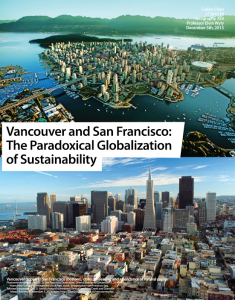Geography has really taught me something crazy this semester – something that’s made me question what I want and the way I see the world. And I love that. So to Professor Elvin Wyly, if you ever read this, thank you for an eye-opening and redefining semester.
Urban Geography was by no means simple to define. This is something that I’ve learned quite well over the last semester. However, it seems like hardly anyone knows how to define it. And that’s okay. From what I’ve gathered, it’s the study of cities, how and why they came it be and how cities have developed societies and vise-versa (mind-city feedback) and what connects cities over time and over space. Sounds easy?
So here I am, taking this course because I thought cities were obviously a solution to becoming more sustainable. It had to be, right? People are closer together, there’s liveliness and density and community. We use less cars, we share ideas, we can consolidate our resources – it’s all great and sustainable, right? Turns out, as my final paper describes, things are not so simple.
I was looking for a solution to how cities can create sustainable changes. What I found, was something much more compelling, complex and real.
Cover Page for my final paper in GEOG350
—
The old mantra “think globally, act locally,” is pretty silly.
-Edward Glaeser, author of Triumph of the City
This, I’ve learned to appreciate to be true. In GRS, we have to keep in mind that our local actions have global impacts. What we do affects someone, somewhere else. In writing my final term paper, this is also what I’ve discovered, is lacking when cities begin to plan for “sustainable development”.
For example, let’s take Vancouver. We live in this beautifully blessed city where nature is both our front yard and our back yard. As Vancouverites, we think we’re pretty sustainable, right? Our government is leading the way with the Greenest Action 2020 Plan, we want Zero-Waste and Climate Action and investing in sustainable food sources, Eco-Density, and the list goes on and on and on.
And I’m not denying that these efforts are making a difference. Especially when we take into account the social benefits that come with promoting these ideas, adopting it in everyday practice and educating current and future on their importance. However, cities are tied, almost always, with the ideas of economic prosperity and growth. And this discourse most definitely has not disappeared from the plans for sustainable city development. In fact, it becomes an integral part of the notion of being sustainable. I think, personally, it’s to counteract the olden day notion that sustainability isn’t profitable – that we must sacrifice economic growth for ecological prosperity. Sustainable development plans in many cities, Vancouver’s included, are compelled to sell the world on these plans.
One may ask: why? Why do they need to “sell” their development plans? And we go back to this relation of local and global. We live in a world where our economies are interconnected – we are globalized. Delving into some of the discourse in Vancouver’s Greenest City Action Plan, we begin to see a pattern emerging. It talks much of economic prosperity by creating green spaces, investing in high density, green buildings and green development, as well as becoming a “mecca for green enterprise.” And again, I am not denying that the initiatives planned are NOT sustainable. But we must look at some compelling facts:
When cities create green spaces and green buildings, they are inviting global investors to develop these projects. For example, Concord Pacific began as Chinese investment in Vancouver’s real estate market. Furthermore, “beautifying” the city with natural capital and increased housing is also a marketing tool to attract businesses, immigrants and tourists alike. For one, the city will become a beautiful place to do business. For others, it will be a beautiful place to visit or live in. In all cases, the Vancouver economy will benefit and the city becomes more sustainable in the process.
It’s all great, right?
Let’s look at the flipside. These actions are benefitting Vancouver and those who live here – there’s a carbon footprint that is not consumed by us. But we shouldn’t forget that nevertheless, there are carbon emissions being created by these actions. Increased flights from increased business and tourism will inevitably increase carbon emissions. This is a result of attracting people to the city.
When we build residences, however dense, we are not only inviting the investors to develop, but the global chain of resources connected with our city that is needed to build these homes.
Lastly, when we build more dense, greener homes, and create an urban environment that increases both the supply and the demand of homes within Vancouver – we will force those who can no longer afford these homes to the edges in the suburbs. All the while, we are focused on the locality of Vancouver; creating jobs and homes within the city and ignoring the effects of expanding suburbs, increased transportation and home maintenance costs, and the eventual carbon footprint that is incurred because of it.
The point of this post is to say that sustainability is not one sided. Sustainable development plans for cities are well-intentioned if not poorly measured. There isn’t one solution or even a simple solution. But in looking for an answer to sustainable cities, through Intro to Urban Geography, I’ve actually found a paradox.
Our actions to create sustainable cities, to sell people on the idea of sustainability, may be the very actions that are, indeed, creating less-sustainable effects and outcomes.
—
Coming to this realization was rewarding, if not a bit saddening. Personally, I believe that focusing on optimistic and positive qualities of sustainability are those that bring about true changes on the general public. It’s about invoking a feeling of accomplishment and of goodness. I don’t know completely what I feel about this discovery. But I am hoping it won’t make me too critical or too cynical about the world around me.



